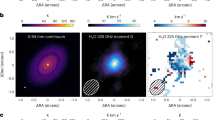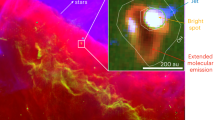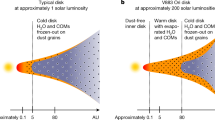Abstract
Planetary systems (ours included) formed in disks of dust and gas around young stars. Disks are an integral part of the star and planet formation process1,2, and knowledge of the distribution and temperature of inner-disk material is crucial for understanding terrestrial planet formation3, giant planet migration4, and accretion onto the central star5. Although the inner regions of protoplanetary disks in nearby star-forming regions subtend only a few nano-radians, near-infrared interferometry has recently enabled the spatial resolution of these terrestrial zones. Most observations have probed only dust6, which typically dominates the near-infrared emission. Here I report spectrally dispersed near-infrared interferometric observations that probe the gas (which dominates the mass and dynamics of the inner disk), in addition to the dust, within one astronomical unit (1 au, the Sun–Earth distance) of the young star MWC 480. I resolve gas, including water vapour and atomic hydrogen, interior to the edge of the dust disk; this contrasts with results of previous spectrally dispersed interferometry observations7,8. Interactions of this accreting gas with migrating planets may lead to short-period exoplanets like those detected around main-sequence stars4. The observed water vapour is probably produced by the sublimation of migrating icy bodies9, and provides a potential reservoir of water for terrestrial planets10.
This is a preview of subscription content, access via your institution
Access options
Subscribe to this journal
Receive 51 print issues and online access
$199.00 per year
only $3.90 per issue
Buy this article
- Purchase on Springer Link
- Instant access to full article PDF
Prices may be subject to local taxes which are calculated during checkout



Similar content being viewed by others
References
Shu, F. H., Adams, F. C. & Lizano, S. Star formation in molecular clouds—Observation and theory. Annu. Rev. Astron. Astrophys. 25, 23–81 (1987)
Safronov, V. S. Evolution of the Protoplanetary Cloud and Formation of the Earth and the Planets [in Russian] NASA TTF-677 (Nauka, Moscow, 1969)
Raymond, S. N., Quinn, T. & Lunine, J. I. Making other Earths: dynamical simulations of terrestrial planet formation and water delivery. Icarus 168, 1–17 (2004)
Lin, D. N. C., Bodenheimer, P. & Richardson, D. C. Orbital migration of the planetary companion of 51 Pegasi to its present location. Nature 380, 606–607 (1996)
Königl, A. Disk accretion onto magnetic T Tauri stars. Astrophys. J. 370, L39–L43 (1991)
Millan-Gabet, R. et al. in Protostars and Planets V (eds Reipurth, B., Jewitt, D. & Keil, K.) 539–554 (Univ. Arizona Press, Tucson, 2007)
Malbet, F. et al. Disk and wind interaction in the young stellar object MWC 297 spatially resolved with AMBER/VLTI. Astron. Astrophys. 464, 43–53 (2007)
Tatulli, E. et al. Constraining the wind launching region in Herbig Ae stars: AMBER/VLTI spectroscopy of HD 104237. Astron. Astrophys. 464, 55–58 (2007)
Ciesla, F. J. & Cuzzi, J. N. The evolution of the water distribution in a viscous protoplanetary disk. Icarus 181, 178–204 (2006)
Drake, M. J. Origin of water in the terrestrial planets. Meteorit. Planet. Sci. 40, 519–527 (2005)
Eisner, J. A. et al. Stellar and molecular radii of a Mira star: first observations with the Keck Interferometer grism. Astrophys. J. 654, L77–L80 (2007)
Colavita, M. M. & Wizinowich, P. L. in Interferometry for Optical Astronomy II (ed. Traub, W. A.) Proc. SPIE 4838, 79–88 (2003)
Colavita, M. et al. Observations of DG Tauri with the Keck Interferometer. Astrophys. J. 592, L83–L86 (2003)
Mannings, V., Koerner, D. W. & Sargent, A. I. A rotating disk of gas and dust around a young counterpart to β Pictoris. Nature 388, 555–557 (1997)
Eisner, J. A., Lane, B. F., Hillenbrand, L., Akeson, R. & Sargent, A. Resolved inner disks around Herbig Ae/Be stars. Astrophys. J. 613, 1049–1071 (2004)
Monnier, J. D. et al. Few skewed disks found in first closure-phase survey of Herbig Ae/Be stars. Astrophys. J. 647, 444–463 (2006)
Eisner, J. A., Chiang, E. I., Lane, B. F. & Akeson, R. L. Spectrally dispersed K-band interferometric observations of Herbig Ae/Be sources: inner disk temperature profiles. Astrophys. J. 657, 347–358 (2007)
Osterbrock, D. E. Astrophysics of Gaseous Nebulae and Active Galactic Nuclei Ch. 4 (Univ. Science Books, California, 1989)
Isella, A. & Natta, A. The shape of the inner rim in proto-planetary disks. Astron. Astrophys. 438, 899–907 (2005)
Ludwig, C. B. Measurements of the curves-of-growth of hot water vapor. Appl. Opt. 10, 1057–1073 (1971)
Pollack, J. B. et al. Composition and radiative properties of grains in molecular clouds and accretion disks. Astrophys. J. 421, 615–639 (1994)
Najita, J., Carr, J. S. & Tokunaga, A. T. High-resolution spectroscopy of BR gamma emission in young stellar objects. Astrophys. J. 456, 292–299 (1996)
Calvet, N. & Gullbring, E. The structure and emission of the accretion shock in T Tauri stars. Astrophys. J. 509, 802–818 (1998)
Muzerolle, J., D'Alessio, P., Calvet, N. & Hartmann, L. Magnetospheres and disk accretion in Herbig Ae/Be stars. Astrophys. J. 617, 406–417 (2004)
Carr, J. S., Tokunaga, A. T. & Najita, J. Hot H2O emission and evidence for turbulence in the disk of a young star. Astrophys. J. 603, 213–220 (2004)
Najita, J. R., Carr, J. S., Glassgold, A. E. & Valenti, J. A. in Protostars and Planets V (eds Reipurth, B., Jewitt, D. & Keil, K.) 507–522 (Univ. Arizona Press, Tucson, 2007)
van den Ancker, M. E., de Winter, D., Tjin, A. & Djie, H. R. E. HIPPARCOS photometry of Herbig Ae/Be stars. Astron. Astrophys. 330, 145–154 (1998)
Marcy, G. et al. Observed properties of exoplanets: masses, orbits, and metallicities. Progr. Theor. Phys. 158 (Suppl.). 24–42 (2005)
Dullemond, C. P., Dominik, C. & Natta, A. Passive irradiated circumstellar disks with an inner hole. Astrophys. J. 560, 957–969 (2001)
Shu, F. et al. Magnetocentrifugally driven flows from young stars and disks. 1: A generalized model. Astrophys. J. 429, 781–796 (1994)
Acknowledgements
Data presented herein were obtained at the W. M. Keck Observatory from telescope time allocated to the National Aeronautics and Space Administration through the agency’s scientific partnership with the California Institute of Technology and the University of California. The Observatory was made possible by the generous financial support of the W. M. Keck Foundation. I thank the entire Keck Interferometer team for their invaluable contributions to these observations. I also acknowledge input into this work (and this manuscript) from R. Akeson, E. Chiang, A. Glassgold, J. Graham, J. Najita and R. White. I am supported by a Miller Research Fellowship.
Author information
Authors and Affiliations
Corresponding author
Ethics declarations
Competing interests
Reprints and permissions information is available at www.nature.com/reprints. The authors declare no competing financial interests.
Supplementary information
Supplementary Information
This file contains Supplementary Notes with additional evidence that effects in the data attributed to water vapor emission are not artifacts of the data calibration or modeling procedures and Supplementary Figure 1 with Legend. (PDF 110 kb)
Rights and permissions
About this article
Cite this article
Eisner, J. Water vapour and hydrogen in the terrestrial-planet-forming region of a protoplanetary disk. Nature 447, 562–564 (2007). https://doi.org/10.1038/nature05867
Received:
Accepted:
Issue Date:
DOI: https://doi.org/10.1038/nature05867
This article is cited by
-
Destruction of fayalite and formation of iron and iron hydride at high hydrogen pressures
Physics and Chemistry of Minerals (2019)
-
Circumstellar disks and planets
The Astronomy and Astrophysics Review (2012)
-
Formation and evolution of planetary systems: the impact of high-angular resolution optical techniques
The Astronomy and Astrophysics Review (2010)
-
Darwin’s warm little pond revisited: from molecules to the origin of life
Naturwissenschaften (2009)
-
Reflected light from sand grains in the terrestrial zone of a protoplanetary disk
Nature (2008)
Comments
By submitting a comment you agree to abide by our Terms and Community Guidelines. If you find something abusive or that does not comply with our terms or guidelines please flag it as inappropriate.



